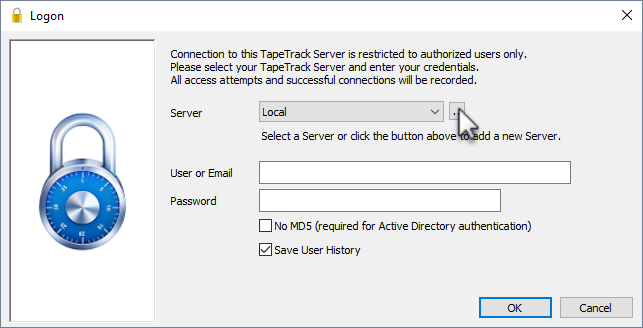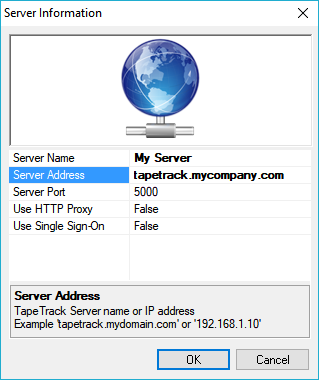Table of Contents
Adding a Desktop Server Connection
When using the TapeTrack Desktop Software you will have to have one or more TapeTrack Framework Server entries defined so that you can connect to a server endpoint.
This can also be achieved in the following ways:
Prerequisites
To configure a server you will need the following information:
- The server IP address or DSN name.
- The server port (usually 5000).
- If you are connecting via a HTTP Proxy:
- The proxy IP address or DNS Name.
- The proxy port.
- The proxy user name (if authentication is required).
- The proxy password (if authentication is required).
Adding a connection interactively
When you run one of the TapeTrack Desktop Programs, you will be prompted to enter credentials to login.
If you do not have any TapeTrack Framework Servers defined, you will be asked if you want to add one.
If you wish to add an additional server, or delete an existing server, you should click the edit button, located next to the Server Selection drop-down Window.
You will then be presented with the Defined Server List. From this list, right-click, and select Add from the Context Menu.
Setting Server Options
In the Edit Server Information Dialog enter:
| Property | Description | |
|---|---|---|
| Server Name | this is the friendly name that you will be shown when selecting the server. It can be any value you personally wish it to be (i.e. MyServer). | |
| Server Address | this is the dotted IP address or DNS server name of your TapeTrack Server. This must be the value provided to you by your TapeTrack Administrator. It can not be an arbitrary value. | |
| Server Port | this is the TCP/IP port of your TapeTrack Server. It will usually be 5000 or 443, but could be any other value assigned by your TapeTrack Administrator. | |
| Use HTTP Proxy | Enable this option if you wish your TapeTrack communications to be sent via a HTTP Proxy. | |
| Use Single Sign-On | Use this option if your TapeTrack Server is in the same Windows network and you wish to use Kerberos Single Sign-On to authenticate. |




